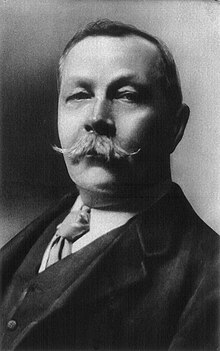About the Book: "The Boscombe Valley Mystery", one of the 56 short Sherlock Holmes stories written by British author, Sir Arthur Conan Doyle, is the fourth of the twelve stories in The Adventures of Sherlock Holmes. It was first published in the Strand Magazine in 1891.
About the Author: Arthur Ignatius Conan Doyle was born on 22 May 1859 at 11 Picardy Place, Edinburgh, Scotland. From 1876 to 1881, he studied medicine at the University of Edinburgh, including a period working in the town of Aston (now a district of Birmingham) and in Sheffield, as well as in Shropshire at Ruyton-XI-Towns. While studying, Doyle began writing short stories. His earliest extant fiction, "The Haunted Grange of Goresthorpe", was unsuccessfully submitted to Blackwood's Magazine. His first published piece "The Mystery of Sasassa Valley", a story set in South Africa, was printed in Chambers's Edinburgh Journal on 6 September 1879. On 20 September 1879, he published his first non-fiction article, "Gelsemium as a Poison" in the British Medical Journal. In 1882 he joined former classmate George Turnavine Budd as his partner at a medical practice in Plymouth, but their relationship proved difficult, and Doyle soon left to set up an independent practice. Arriving in Portsmouth in June of that year with less than £10 (£900 today) to his name, he set up a medical practice at 1 Bush Villas in Elm Grove, Southsea. The practice was initially not very successful. While waiting for patients, Doyle again began writing stories and composed his first novels, The Mystery of Cloomber, not published until 1888, and the unfinished Narrative of John Smith, which would go unpublished until 2011. He amassed a portfolio of short stories including "The Captain of the Pole-Star" and "J. Habakuk Jephson's Statement", both inspired by Doyle's time at sea, the latter of which popularized the mystery of the Mary Celeste and added fictional details such as the perfect condition of the ship (which had actually taken on water by the time it was discovered) and its boats remaining on board (the one boat was in fact missing) that have come to dominate popular accounts of the incident. Doyle struggled to find a publisher for his work. His first significant piece, A Study in Scarlet, was taken by Ward Lock Co. on 20 November 1886, giving Doyle £25 for all rights to the story. The piece appeared later that year in the Beeton's Christmas Annual and received good reviews in The Scotsman and the Glasgow Herald. The story featured the first appearance of Watson and Sherlock Holmes, partially modeled after his former university teacher Joseph Bell. Doyle wrote to him, "It is most certainly to you that I owe Sherlock Holmes ... Round the center of deduction and inference and observation which I have heard you inculcate I have tried to build up a man." Robert Louis Stevenson was able, even in faraway Samoa, to recognize the strong similarity between Joseph Bell and Sherlock Holmes: "My compliments on your very ingenious and very interesting adventures of Sherlock Holmes. ... Can this be my old friend Joe Bell?" Other authors sometimes suggest additional influences—for instance, the famous Edgar Allan Poe character C. Auguste Dupin. A sequel to A Study in Scarlet was commissioned and The Sign of the Four appeared in Lippincott's Magazine in February 1890, under agreement with the Ward Lock company. Doyle felt grievously exploited by Ward Lock as an author new to the publishing world and he left them. Short stories featuring Sherlock Holmes were published in the Strand Magazine. Doyle first began to write for the 'Strand' from his home at 2 Upper Wimpole Street, now marked by a memorial plaque. In this period, however, Holmes was not his sole subject and in 1893, he collaborated with J.M. Barrie on the libretto of Jane Annie. Doyle was found clutching his chest in the hall of Windlesham Manor, his house in Crowborough, East Sussex, on 7 July 1930. He died of a heart attack at the age of 71. His last words were directed toward his wife: "You are wonderful." At the time of his death, there was some controversy concerning his burial place, as he was avowedly not a Christian, considering himself a Spiritualist. He was first buried on 11 July 1930 in Windlesham rose garden. He was later reinterred together with his wife in Minstead churchyard in the New Forest, Hampshire. Carved wooden tablets to his memory and to the memory of his wife are held privately and are inaccessible to the public. That inscription reads, "Blade straight / Steel true / Arthur Conan Doyle / Born May 22nd 1859 / Passed On 7th July 1930." The epitaph on his gravestone in the churchyard reads, in part: "Steel true/Blade straight/Arthur Conan Doyle/Knight/Patriot, Physician, and man of letters". Undershaw, the home near Hindhead, Haslemere, south of London, that Doyle had built and lived in between October 1897 and September 1907, was a hotel and restaurant from 1924 until 2004. It was then bought by a developer and stood empty while conservationists and Doyle fans fought to preserve it. In 2012 the High Court ruled that the redevelopment permission be quashed because proper procedure had not been followed. A statue honours Doyle at Crowborough Cross in Crowborough, where he lived for 23 years. There is also a statue of Sherlock Holmes in Picardy Place, Edinburgh, close to the house where Doyle was born.
My Review: Although a short story, the plot is sufficiently complex and entertaining:
Lestrade, a Scotland Yard detective, summons Holmes to a community in Herefordshire, where a local landowner has been murdered outdoors. The deceased's estranged son is strongly implicated. Holmes quickly determines that a mysterious third man may be responsible for the crime, unraveling a thread involving a secret criminal past, thwarted love, and blackmail.
Sherlock Holmes and Dr. Watson take a train to Boscombe Valley, in Herefordshire. En route, Holmes reads the news and briefs Watson on their new case.
Mr. John Turner, a widower and a major landowner who has a daughter named Alice, lives there with a fellow expatriate from Australia, Mr. Charles McCarthy, a widower who has a son named James. Charles has been found dead near Boscombe Pool. It was reported that he was there to meet someone. Two witnesses testify that they saw Charles walking into the woods followed by James, who was bearing a gun. Patience Moran, daughter of a lodge keeper, says she saw Charles and James arguing and, when James raised his hand as if to hit his father, she ran to her mother. While telling her mother what she saw, James rushed to their house seeking help. The Morans followed James back to the Pool, where they found his father dead. James was arrested and charged with murder. Alice Turner believes James is innocent and has contacted Lestrade, a Scotland Yard detective who in turn has asked Holmes’ help.
James confirms the testimonies of the witnesses, but explains that he went to the woods to hunt, not to follow his father. He later heard his father calling "Cooee", and he found his father standing by the pool, surprised to see him. They argued heatedly, and James decided to return to Hatherley Farm. Shortly thereafter, he heard his father cry out, and returned to find his father lying on the ground. James insists that he tried to help him, but his father died in his arms. James refuses to reveal the cause of their argument, despite the coroner's warning that it could be damaging to his case. James also remembers his father’s last words were something about "a rat", but James is uncertain of the meaning. He also saw a cloak nearby that was gone when he returned later.
Alice meets Holmes, Watson and Lestrade in the hotel; she hopes Holmes has found a way to prove James' innocence. She also believes that she was the subject of the argument between James and his father, for Alice had asked James to marry her but James refused. Alice's father was also against the union. Holmes asks Alice if he could meet her father, but she says his health worsened after the death of Charles, whom he had known since they were in Victoria. Holmes decides to see James.
Holmes mistakenly surmises that James knows who killed his father and is only protecting someone. Alice is right about the cause of the argument between James and Charles. What she does not know is that James loves her and wants to marry her, but could not because he had already married a barmaid before Alice returned from boarding school. This burdens him, but he cannot tell his father about his marriage because he would be thrown out of the house and left unable to support himself. To James’ consolation, when his wife hears of his troubles, she confesses she was already married before they met, and therefore their marriage is invalid.
Holmes, Watson and Lestrade go to Hatherly Farm and examine Charles' and James' boots. They then head to Boscombe Pool, following the track from the courtyard. After examining the ground, Holmes finds evidence of the presence of another man besides Charles and James, whom he believes to be the murderer. The stranger is a tall, limping, left-handed man who smokes cigars (Watson having helped Holmes deduce the killer's left-handed nature because the victim was struck neatly on the left side of the head from behind where a right-handed man would have struck him on the other side). Lestrade is not convinced.
At the hotel, Holmes explains to Watson that "Cooee" is an Australian cry and "a rat", overheard by James, were the last syllables of "Ballarat", a place in Australia. So the person Charles was meeting is someone he knew from Australia. John comes to their room (entering with Holmes' predicted limp) and, realising that Holmes has deduced the crime, confesses.
In his confession, John explains that he was a member of the Ballarat Gang, a group of bushrangers in Australia. They robbed a gold convoy in which Charles was the wagon driver, and John spared his life despite knowing that Charles could identify him. The loot made the gang rich, and they moved to England. Resolved to change, John parted ways with his friends. He bought land, married, and then Alice was born. John met Charles again by chance, and Charles threatened to blackmail him. In response John gave Charles Hatherly Farm and money. Eventually this was not enough, and Charles demanded the marriage of James and Alice. Although he likes James, John could not allow Charles eventual control over his family's finances through Alice, and resisted the union. After much pressure, John agreed to meet Charles secretly at the Pool. Seeing Charles and James there arguing, John waited till James left. Then he killed Charles to preserve his freedom and spare his daughter. James heard his father's death cry and returned, but John was able to hide in the woods. He had to return later to retrieve a cloak that he dropped in his haste.
John signs his statement, and Holmes vows to keep it secret unless needed to free James.
Holmes' objections are sufficient to acquit James. John passes away seven months after the meeting with Holmes and Watson. James and Alice marry, without knowing the mysterious past of their fathers.
Very entertaining and well written story, I recommend this book to any reader who appreciates mystery and Sherlock Holmes adventures. You will not be disappointed.
If you read my review, feel free to leave a comment!



No comments:
Post a Comment